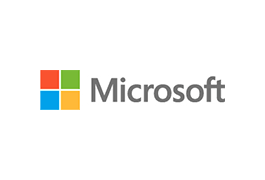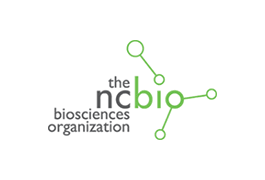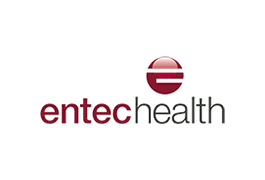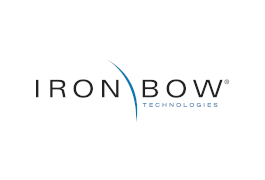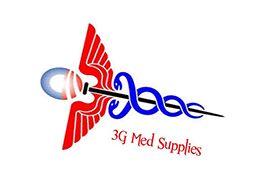14 December, 2013
Barlow Respiratory Hospital is a long-term acute care (LTAC) facility using the Silhouette® system as the centerpiece of its Wound Care Program for pressure ulcer surveillance.
Barlow is a 105-bed hospital network in Los Angeles admitting more than 700 chronically critically ill and medically complex patients per year for ventilator weaning and treatment of multiple co-morbid conditions. The average length of stay is 35 days. The hospital opened more than a century ago as a tuberculosis sanitorium and now functions as a highly regarded long-term care facility for people suffering from severe respiratory illnesses.
Barlow’s wound specialist, Kathy Deck, RN, CWON implemented Silhouette in 2009.
Silhouette has enabled Barlow to improve skin assessment and documentation of wounds and wound healing outcomes, and streamline an increasingly taxing documentation workload.
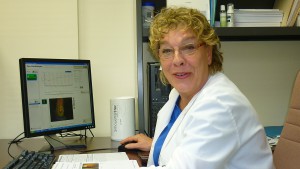
Kathy Deck uses Silhouette to review the point of care wound assessments of Barlow Respiratory Hospital staff.
Barlow staff can monitor and have early warning of worsening or non-healing wounds due to Silhouette’s high levels of accuracy – up to 98% for area, with high inter- and intra-rater reliability. It also provides quality wound imaging and display of healing progress.
ICU and ward nurses use smart SilhouetteStar™ wound cameras on the units to image and measure all alterations in skin integrity: pressure ulcers, surgical wounds, arterial venous and diabetic ulcers, and any non-intact and discoloured skin, documenting their assessments within 24 hours of admission. Patients are thereafter imaged weekly and also at discharge.
If you catch just one pressure ulcer present on admission, and you don’t get penalized as a hospital-acquired, you have proven the value of the system.
– Kathy Deck, RN, CWON, wound specialist, Barlow Respiratory Hospital
Prioritizing patients
The point of care assessments are synchronized to the Silhouette database, which is integrated with the hospital’s Electronic Medical Record (EMR) system. Ms Deck uses the system to monitor all wound assessments, correct inaccuracies and identify the exceptional cases that need her specialist attention. This allows her to prioritize the patients requiring her personal intervention, and provides reliable objective data for the hospital’s host of required reporting and audits.
Before implementing Silhouette, Barlow staff assessed patients’ wounds visually using paper tape measures to calculate wound area; cotton-tipped applicators were used to assess wound depth. Wound measurements were inconsistent and variable largely due to a wide range of bedside caregiver proficiency. And wound care-related paperwork was cumbersome and rework was frequent.
To image wounds, nurses took instant photos that could be printed out and affixed to the paper record for documentation. The team later switched to digital cameras, but there were ongoing issues with the quality and uniformity of photos. In addition, all labeling of photos was performed manually.
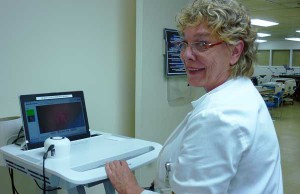
Ms Deck demonstrates how Silhouette is set up for point of care pressure ulcer assessments.
The success of the Silhouette system hinges on its ability to quickly and accurately capture all assessment information providing: high quality images linked to the patient ID, automatic measurement of area and depth, calculation of healing progression, plus the capture of assessment notes and powerful reporting in a secure, compliant system while decreasing the opportunity for human variation and error.
Improving overall capability
One of Silhouette’s major benefits has been its value as a tool to improve overall wound assessment capability among RN bedside staff. “Capturing the wound in one shot with Silhouette means the digital image and assessment are together, “ says Ms Deck. “It means you have all the tools you need at your disposal. I use Silhouette as a learning tool. I can say to a nurse, ‘Let’s look at this together, this is what I’m seeing.’ The nurse incorporates the feedback into his or her subsequent assessments, creating a robust cycle of performance.”
Because the bedside nurses are assessing with more accuracy, Ms Deck is spending less time correcting errors, providing more time for exceptional wound care issues and staff education.
Now, with Ms Deck using Silhouette to improve organizational wound assessment performance, Barlow has gained far greater control over wound outcomes and is prepared for pay-for-performance wound care. It also facilitates Barlow’s ability to meet documentation deadlines, comply with audits, meet mandatory quality data submission requirements and avoid penalties.
“Having good documentation is absolutely vital. If your hospital is relying on a wound specialist, it is easy to miss things. Silhouette enables me to easily monitor wound status. So if a pressure ulcer develops or worsens, Silhouette enables me to catch it before it gets out of hand so we can get aggressive and heal it up before it goes to a III or IV, to where it’s reportable,” she says.
Extending reach of wound specialist
Silhouette ensures Barlow knows its exact status regarding wound numbers – particularly pressure ulcers.
“I’m comfortable with the numbers because I know they are accurate,” says Ms Deck. “Other entities only have one set of eyes that can’t monitor everything. With Silhouette, I can see what’s going on – it’s as if I am overseeing the wound care program with 100 pairs of eyes and accurately capturing what’s really going on.”
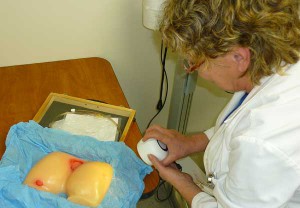
Ms Deck demonstrates how Silhouette is used to image, measure and document wounds using Silhouette’s innovative, non-invasive laser technology.
On average, nearly 50% of patients have at least one stage II or higher pressure ulcer on admission to Barlow; up to 25% have multiple ulcers. Silhouette enables Barlow to keep up with the typical 60-70 admission and follow-up assessments it must make each week.
Says Ms Deck, “Without Silhouette, there’s no way I would have timely access to the clinical information that I need for mandatory submissions within a very specific short time frame.”
Barlow can prove that it heals 50% of all wounds before patients are discharged, and that most hospital-acquired pressure ulcers (HAPU) do not progress beyond Stage II. This provides an evidence base for communications with physicians, patients, families and regulatory bodies along the care continuum, and also serves as a valuable marketing tool for Barlow’s contracting efforts
With the powerful combination of a wound specialist plus the monitoring capability of Silhouette, Barlow has been able to leverage Ms Deck’s skill so that the wound care competence of the entire organization has improved. Nurses have embraced the system and use it consistently, kn owing that accurate assessment and early identification of wounds leads to prompt treatment to prevent progression.
Return on investment
Ms Deck says Silhouette more than pays for itself. “If you catch just one pressure ulcer present on admission, and you don’t get penalized as a hospital-acquired, you have proven the value of the system.”
“There are numerous studies detailing how much a pressure ulcer costs. Silhouette didn’t even cost me one ulcer.”
Barlow case study – PDF version


